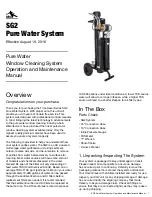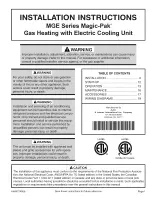
The manufacturer’s warranty does not cover any damage or defect
caused by installation, or attachment, or use of any special attach-
ment such as energy saving devices (other than those authorized
by the manufacturer) into, onto, or in conjunction with the water
heater. The use of such unauthorized devices may shorten the
life of the water heater and may endanger life and property. The
manufacturer disclaims any responsibility for such loss or injury
resulting from the use of such unauthorized devices.
1. INSPECT SHIPMENT — for possible damage. The manufacturer’s
responsibility ceases upon delivery of goods to the carrier in good
condition. Any claims for damage, shortage in shipments, or non de-
livery must be filed immediately against carrier by consignee.
2. THERMAL EXPANSION — Determine if a check valve exists in the
inlet water line. It may have been installed in the cold water line as a
separate back flow preventer, or it may be part of a pressure reduc-
ing valve, water meter or water softener. A check valve located in
the cold water inlet line can cause what is referred to as a ”closed
water system”. A cold water inlet line with no check valve or back
flow prevention device is referred to as an ”open” water system.
As water is heated, it expands in volume and creates an increase
in the pressure within the water system. This action is referred to as
”thermal expansion”. In an ”open” water system, expanding water
which exceeds the capacity of the water heater flows back into the
city main where the pressure is easily dissipated.
A ”closed water system”, however, prevents the expanding water
from flowing back into the main supply line, and the result of ”thermal
expansion” can create a rapid, and dangerous pressure increase in
the water heater and system piping. This rapid pressure increase can
quickly reach the safety setting of the relief valve, causing it to oper-
ate during each heating cycle. Thermal expansion, and the resulting
rapid, and repeated expansion and contraction of components in the
water heater and piping system can cause premature failure of the
relief valve, and possibly the heater itself. Replacing the relief valve
will not correct the problem!
The suggested method of controlling thermal expansion is to install an
expansion tank in the cold water line between the water heater and the
check valve. The expansion tank is designed with an air cushion built in
that compresses as the system pressure increases, thereby relieving
the over pressure condition and eliminating the repeated operation of
the relief valve. Other methods of controlling thermal expansion are also
available. Contact your installing contractor, water supplier, or plumbing
inspector for additional information regarding this subject.
If a recirculation line is installed, the return connection should be made
to a tee close to the inlet connection on the water heater. A check valve
should always be installed in the recirculation line to prevent cold water
from entering.
WATER CONNECTIONS — This water heater may be connected indi-
vidually, in multiples with others, or with an external hot water storage
tank.
Inlet water connections are made to the lower coupling on the heater,
and outlet water connections are made to the upper coupling.
Each water heater is supplied with the necessary components (Diffuser
tubes) to make the water connections that will ensure proper perfor-
mance. The components are supplied in a bag attached to the water
heater. If special instructions are required for any specific water heater,
they will be included in the bag.
Cap or plug unused connections. Use only clean, new galvanized steel,
copper or approved plastic pipe for water connections. Local codes
or regulations shall govern the exact type of material to be used. The
installation of unions on the inlet and outlet water lines and a shut-off
valve in at least the cold water inlet line is recommended, so the water
heater may be easily disconnected for servicing. Dielectric unions are
not required for protection of water heater.
When this water heater is supplying general purpose hot water require-
ments for use by individuals, a thermostatically controlled mixing valve
is recommended to reduce the risk of scald injury. Contact a licensed
plumber or the local plumbing authority for further information.
Thermometer(s) should be installed so that they indicate the tempera-
ture of the water at or near the outlet of the water heater and storage
tank(s) if provided. See Fig. 4 on page 7.
3. RELIEF VALVE — A new factory installed combination pressure and
temperature relief valve, complying with the Standard for Relief Valves
and Automatic Gas Shutoff Devices for Hot Water Supply Systems,
ANSI Z21.22, or Standard CAN1-4.4, Temperature, Pressure, Tempera-
ture and Pressure Relief Valves and Vacuum Relief Valves is provided
with the water heater. No valve is to be placed between the relief valve
and the water heater. For a circulating tank installation, the separate
storage tank(s) must have similar protection. The pressure rating of the
relief valve must not exceed 150 psi (160 psi for ASME models), the
maximum working pressure as marked on front of the water heater.
The Btu/h rating of the relief valve must equal or exceed the Btu/h input
of the water heater as marked on its rating plate.
Connect the outlet of the relief valve to a suitable open drain. The
discharge line must pitch downward from the valve to allow complete
draining (by gravity) of the relief valve and discharge line, and be no
smaller than the outlet of the valve. The end of the discharge line
should not be threaded or concealed and should be protected from
freezing. No valve of any type, restriction or reducer coupling should be
installed in the discharge line. Local codes shall govern the installation
of relief valves.
4. GAS SUPPLY — The inlet gas pressure to the water heater must not
exceed 10.5” w.c. (2.6 kPa) for Natural gas. For purposes of input adjust-
ment, the minimum inlet gas pressure (with main burner on) is shown on
the rating plate. Check to see if high or low gas pressure is present and
then contact the gas company for correction.
The gas line should be of adequate size to prevent undue pressure
drop. Sizing based upon Table 1 (on pg. 13) is recommended. No ad-
ditional allowance is necessary for an ordinary number of fittings.
A ground joint union and manual shutoff valve should be installed in
the gas line near the water heater so that the burner assembly may
be easily removed. The shut-off valve must be readily accessible for
turning on or off. See Fig. 4 on page 7.
A sediment trap must be installed at the bottom of the gas line. See
Fig. 4 on page 7.
LEAK TESTING — The water heater and its gas connections MUST
be leak tested at normal operating pressure before it is placed in op-
eration. Turn ON the manual gas shut-off valve near the water heater.
Use a soapy water solution to test for gas leaks at all connections and
fittings. Bubbles indicate a gas leak that must be corrected. The water
heater factory connections to the gas valve should also be leak tested
after placing the water heater in operation.
6
installation
WARNING
!







































